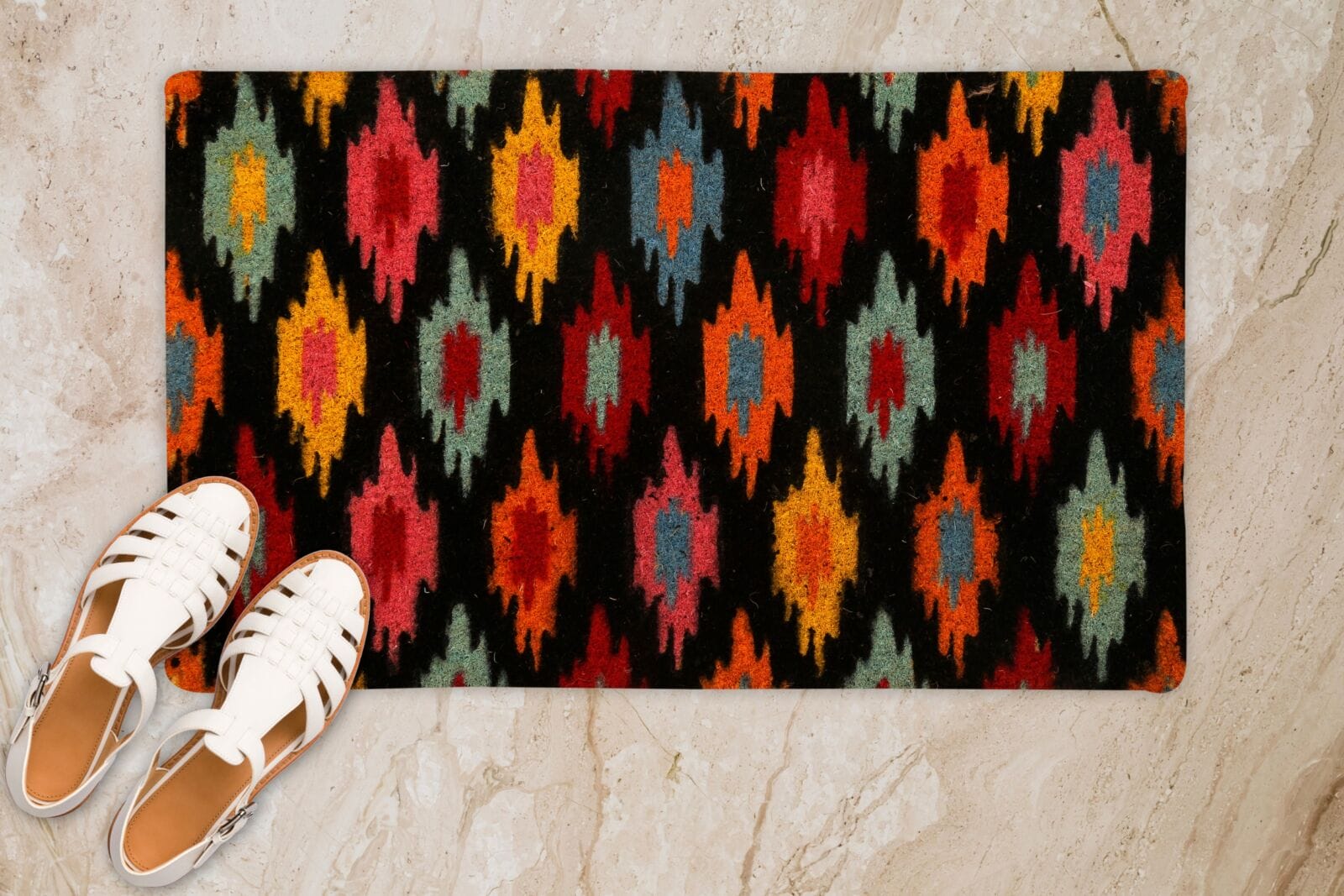So, you’ve decided to adopt a new lifestyle…or rather, an old one. You’ve become intrigued by Native American culture and their beautiful design techniques. These aren’t just images of a forgotten past; they’re a reflection of a vibrant culture that continues to thrive. Part and parcel of embracing this style is the use of the transformative Southwestern rug. Let’s embark on this enlightening journey together.
The Origin of Southwestern Rugs
Southwestern rugs have long been the cornerstone of Native American design. The Navajo tribes, who resided in the southwestern regions of North America, are especially renowned for their distinctive rug weaving artistry. Originating from sheep’s wool, these handcrafted works of art initially came into being as practical necessities such as blankets or clothing.
However, as trade routes opened up in the late 1800s, these uniquely patterned weavings became sought-after commodities across America. The prominence of railroad systems provided unprecedented access to markets far beyond the Navajo tribes’ territories, enabling them to establish flourishing trading posts. As a result, the Southwestern rug underwent its metamorphosis into an iconic symbol of Native American craftsmanship.
To this day, the legacy lives on. Native American style and Southwestern area rugs are still revered for their intricate designs and high-quality craftsmanship. They serve not only as home decor but also as a tactile connection to a rich cultural history.
The AZIA (American Zonal Interior Association), an interior design organization, recognizes these rugs as a vital part of bringing life and vibrancy to any room. Reflecting age-old traditions that span generations, each Southwestern rug intertwines deep cultural roots with contemporary aesthetics effortlessly.
Importance in Native American Culture
The role of Southwestern rugs within Native American culture transcends mere aesthetics. Woven into their fabric is the spirit of a community, the mark of generations, and a reservoir of narratives. Rugs are considered an essential part of cultural expression, embodying tribal stories, traditions, and religious beliefs.
From birth to death, these rugs play a vital role in every Native American’s life journey. They are used in ceremonial dances, weddings, births, burials and in healing rituals as charms against evil spirits. Some tribes consider them to be a bridge between this world and the spiritual one.
More than just functional items or decorative pieces, these rugs have a beautiful way of keeping history alive. Each pattern tells a personal story that echoes with the wisdom and experience of countless generations. They continue to be indispensable to tribal identity, fostering pride and nurturing the essence of their incredible heritage.
In the modern age, where all too often material goods lack personal connection and meaning, Southwestern rugs stand as a testament to a way of life that values tradition above all else.
Rug Weaving Techniques
The artistry behind Southwestern rugs demonstrates centuries-old techniques passed down through generations. From shearing wool off animals to spinning it into fine yarns for the loom; every step is an intricate process showcasing exceptional skills honed over time.
Typically these rugs are woven on vertical looms – just as they were centuries ago. The weaver begins at the bottom and works upwards, integrating various colored yarns to bring their unique designs to life. Maintaining the right tension and symmetry is crucial to ensure impeccable craftsmanship.
Experts can recognize different tribes by their weaving styles. Pueblo weavers use cotton warp and colorful woolen weave – striking contrasts to Navajo’s all-wool, heavier rugs. The Hopi tribe is famous for their third-phase chief blankets with mesmerizing stepped and triangle designs.
With commitment to authenticity, possessing a Southwestern rug isn’t just about owning a piece of decor, but about cherishing a tangible slice of history each day.
Identifying Genuine Southwestern Rugs
Genuine Southwestern rugs are an extension of Native American heritage and art. Recognizing the real deal from cheap imitations can be tricky, but there are tell-tale signs. Perhaps chief among them is the method of construction. Authentic Southwestern rugs are hand woven on looms, making the design visible on both sides of the rug.
The texture of genuine rugs also sets them apart. They are made from sheep’s wool – no synthetics – resulting in a unique softness that can’t be duplicated. Patterns and colors used also lend clues: authentic rugs stick to earthy tones and have unique geometric patterns reflecting Native American cosmos or motifs.
A genuine rug is more than just a floor covering; it is a passage into tribal history. So, if you’re keen to incorporate true cultural elements into your space, don’t hesitate to seek out the real thing.
Remember that each genuine rug supports the livelihoods of Native American artists too – sustaining cultural continuity while standing proudly against mass-produce culture.
Symbolism in Rug Designs
Southwestern rugs carry deep symbolic meanings through their complex patterns. They are interpretations of life’s philosophy as observed by Native American tribes over centuries.
Geometric patterns reflect balance, suggesting order and harmony in the universe while certain shapes represent various natural elements: rectangles symbolize mountains, zigzag lines represent water or lightning. The use of spiders or butterflies are popular motifs illustrating transformation or regeneration too.
Distinct tribal stories are emblazoned in the rug patterns. The iconic ‘Eye-Dazzler‘ rug boasts of vibrant colors and intricate designs that were traditionally used to distract the evil eye from people or important objects. Many believe such rugs protect against negative energies.
Therefore, when you invite a Southwestern rug into your space, you don’t just bring in an artistic masterpiece, but also a symbol with deep spiritual and cultural significance. Truly, these rugs are as transformative as they are beautiful.
Color Choices and Their Meanings
An integral part of Southwestern rug design is its rich color palette. Each hue carries a unique significance rooted in Native American beliefs.
- Blue: Often associated with the sky, water, and endless horizons, blue embodies tranquility and the concept of infinity. It is often used to denote wisdom and confidence.
- Red: Symbolic of vitality and energy, red reflects the colors of sandstones and clay pots that dot the Southwestern landscape.
- Brown: Brown is closely associated with Mother Earth, representing stability and strength.
- White: Usually stands for purity, peace or spirit.
- Black: Commonly used to depict dark or night.
Coupled with tribal motifs, these colors tell compelling stories – from tales of bravery to glimpses into ceremonial rites. Authentic rugs weave these colors harmoniously – creating an enchanting mosaic of tribal history.
Maintaining and Preserving Southwestern Rugs
A prized possession like a Southwestern rug deserves special care. Regular cleaning keeps them bright and fresh-looking; however, harsh chemicals can damage their fibers. Use gentle wool-safe cleaners instead. For spot cleaning, blot out stains with a clean damp cloth; never rub or scrub forcefully.
While vacuuming helps stave off dust accumulation, avoid high suction or beater bar; it can pull out fibers or fray ends. Instead use a carpet sweeper for routine freshening.
Avoid direct sunlight as it can cause colors to fade. Rotate your rug every few months to promote even wear. Finally, consider professional rug cleaning every few years; specialists will know best how to care for these works of art.
Treat them right, and your rug can stay beautiful for generations – a timeless testament to the Native American tradition.
Incorporating Rugs into Home Decor
Southwestern rugs excel in transforming even the most mundane spaces into cultural retreats. Their vibrant patterns and pleasing aesthetics breathe life into any room. Whether laid on a wooden floor or draped over a sofa, they add an inviting warmth.
For living rooms, consider placing your prized rug beneath coffee tables or tying together seating areas. To accentuate hallways or entryways, runners with tribal elements create welcoming vibes.
In bedroom decor, use Southwestern rugs as vibrant wall hangings or lay them beside your bed for a soft landing each morning. Kitchens to benefit from this touch of culture; smaller rugs bring comfort underfoot while busy at the stove. Do be mindful of spill-prone or damp areas; it’s best to keep these treasures clear!
Evidently, incorporating these rugs isn’t about sticking to a strict rule book – it’s about letting their spirit infuse new life into your space.
Where to Purchase Southwestern Rugs
When on the lookout for genuine Southwestern rugs, opt for establishments that support and uphold Native American artists. Many tribal communities run their own trading posts online where they sell authentic handcrafted pieces directly. This not only provides you with unique pieces but also supports their livelihoods.
Antique stores and auction houses can also be hunting grounds for vintage finds. Do take note of their reputation and commitment to ethical practices before purchasing.
If online shopping is preferred, websites dedicated solely to Southwestern rugs offer a wide variety. Again, check for authenticity markers and read customer reviews for assurance.
Ethical Considerations When Buying
While indulging in this art form, remember that each Southwestern rug is intimately tied to tribal identity. Avoid mass-produced replicas, which undermine artists’ hard work and trivialize their symbols and narratives.
Learn to differentiate between genuine hand-woven rugs and machine-made copies. Honor indigenous artistic rights by buying directly from artisans or sellers with established connections with tribes.
Say no to the destructive cycle of cultural appropriation by supporting fair-trade practices. Your thoughtful decisions respect Native American heritage and safeguard the vibrancy of this living culture.
Final Thoughts
Embracing Southwestern rugs means more than adopting an interior design trend; it’s about paying tribute to the enduring legacy of Native American cultures. Their vivid colors speak not just to our eyes but also to our souls, intertwining past with present in intricate weavings. As you admire an authentic Southwestern rug, remember you’re treasuring a thread of history, a tale whispered in wool and color.




